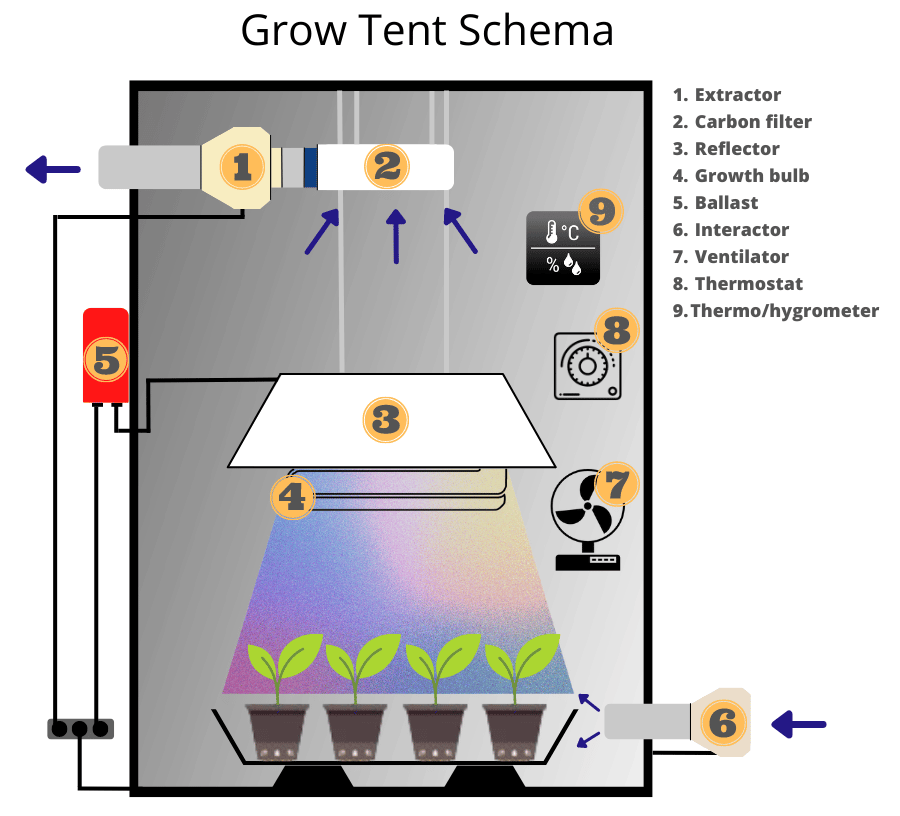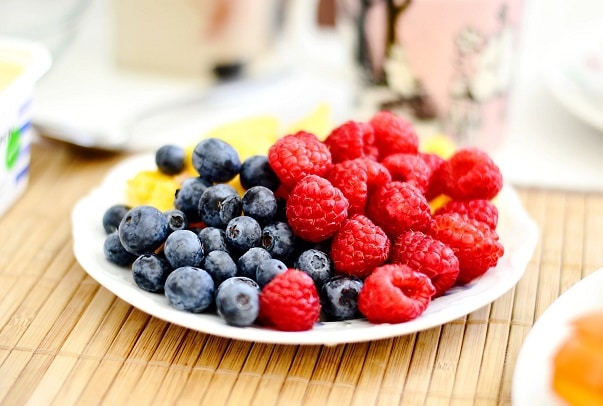
I bet you love juicy and luscious fruits. Just imagine that you could grow your favorite tasty fruit regardless of the weather. Interested? Then read on to find out how to grow hydroponic fruit!
Hydroponics is a method of plant growth in water with no soil. Minerals and nutrients in the mix are at optimum levels. So, the plants can devote their energy to produce fruits and vegetables. It results in higher yields.
Growing fruit with hydroponics means that you can grow fruit regardless of the season or the outside climate. Hydroponics enables you to simulate the best possible environment for your fruit plants. The right nutrients at the right time allow them to grow quickly and healthily. This blend of environment feeding gives a good taste. Your fruits will be healthy with big yields shortly! It’s way better than traditional gardening!
 Before you start growing fruit hydroponically, you’ll need to pick the system to start with. Our top articles: Our Picks for the 5 Grow Tent Kits, Picks for the 5 Aeroponics Systems, Our Picks for the 5 Hydroponic Bucket Systems with Buyer’s Guides, and Our Picks for the 5 best indoor vertical Garden, and Led Grow Lights for an indoor plant, and The Best Hydroponic Tower for Indoor Garden.
Before you start growing fruit hydroponically, you’ll need to pick the system to start with. Our top articles: Our Picks for the 5 Grow Tent Kits, Picks for the 5 Aeroponics Systems, Our Picks for the 5 Hydroponic Bucket Systems with Buyer’s Guides, and Our Picks for the 5 best indoor vertical Garden, and Led Grow Lights for an indoor plant, and The Best Hydroponic Tower for Indoor Garden.
Here you are, with the guide to grow the best fruits hydroponically.
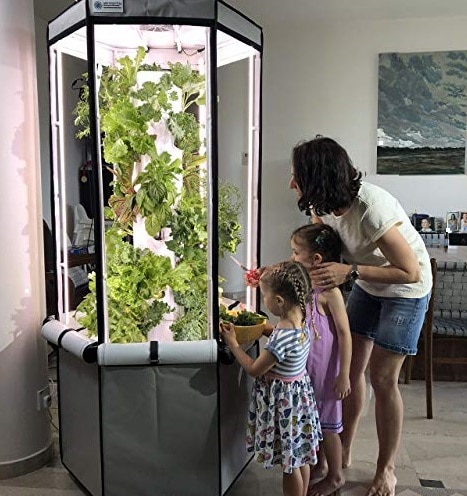
 Aerospring 27-Plant Vertical Hydroponics Indoor Growing System
Aerospring 27-Plant Vertical Hydroponics Indoor Growing System
- Easy to use aeroponic system for your home
- Fan - Grow Lettuce, Herbs, Veggies & Fruits
- Grow smart & eat healthy, 20 gallon water reservoir Grow Tent, LED Grow Lights
What Are Hydroponic Fruits?
Hydroponics is a modern technology for growing plants. They can grow in water without using the soil. Required minerals and nutrients get to the water in optimal quantities. So, plants can use their energy to produce fruits and vegetables. Also, they can obtain generous yields. Much has been written and read about hydroponic cultivation. It’s an innovative and excellent way to encourage home gardening.
If you want to pick fresh good smelling juicy fruits, yes, hydroponics does wonder. Today, we are going to show you the best fruits to grow in hydroponics. This article will help you learn how to pick delicious fruits out of your hydroponic system.
What Fruit Can Grow Hydroponically?
I have my top choices for the fruits you may grow in hydroponics. I want to show you the list of the best fruits for hydroponics gardening. It comes with brief information on their cultivation method.
Hydroponic Strawberries

There’s no such thing as a large bowl of berries on a hot summer afternoon or a strawberry pie in the winter. You can grow strawberries in hydroponics all year long. With hydroponics, they’re still large and juicy.
Fortunately, the cultivation of strawberries with a hydroponic system is much simpler than you could ever think. They’re perfect for novices. So, juicy strawberries are good while choosing fruits to grow in hydroponics.
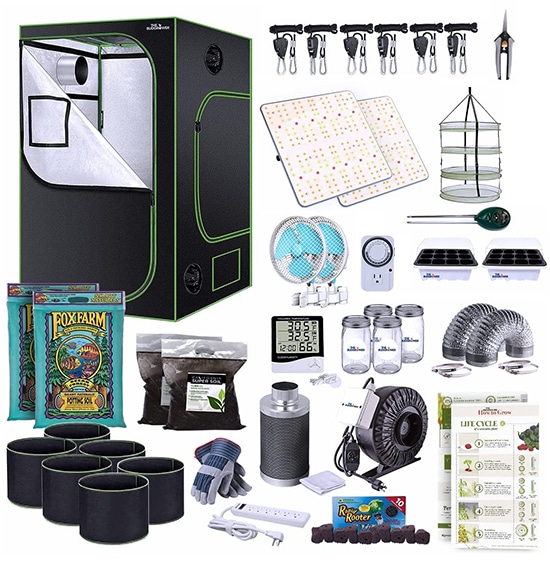 TheBudGrower Complete All-in-One Home Grow Solution 4x4x7ft- 2200W(2)
TheBudGrower Complete All-in-One Home Grow Solution 4x4x7ft- 2200W(2)
- LED lights specialty manufactured by VIVOSUN with Samsung LM301 diodes for FULL spectrum light
- The industries most durable grow tent – heavy duty 1680d oxford cloth
- Money & energy saving complete home grow tent kit
Given their user-friendly character, they can also be a good choice for commercials. Don’t go for seeds. My advice is to start with rootstock ever-bearing strawberries. You can buy them at any greenhouse. The reason for this is that seeds can take a while to grow.
Besides, you don’t have to give it a lot of nutrient solutions. It should be just about 700-800 PPM. So, I can say that it was my bad when I added too much feedstuff, and the leaves became brown.
When you decide on a particular kind of soilless system for strawberries, you may use any type. But still, the most preferable option would be the NFT (Nutrient Film Technique). It supports and feeds the fruit properly. You’ll want to ensure that you start clean fruits in a system. It’ll help avoid the probability of root disorder.
Hydroponic Watermelon
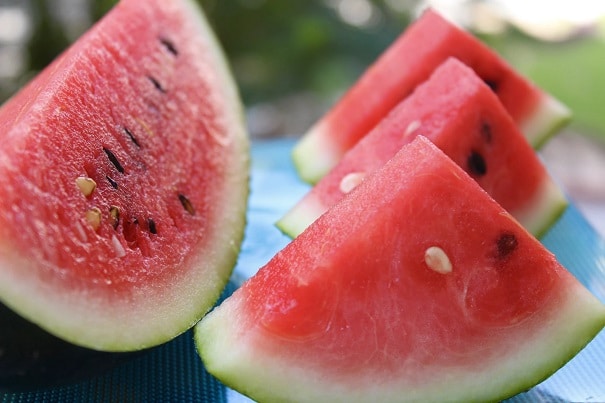
Let’s move on to another delicious fruit. Watermelon is a godsend fruit by nature. It provides relief on the hot sunny days in the summer. Just imagine having a watermelon hydroponics garden in your home. It’d be so gratifying!
It doesn’t matter how large the fruit is. The main concern is to ensure that they have adequate light support for their weight.
Most hydroponics systems are suitable for watermelon cultivation. If you grow several plants simultaneously, then an Ebb and Flow system is the best choice. It uses a single tank to deliver nutrients to several hydroponic units at a time. This reduces the time devoted to the verification of nutrient levels and the addition of solutions.
Growing watermelons indoors from seeds is the most preferred method for the hydroponic system. Start sprouting seeds in the growing medium, such as Rockwool or peat starters. Water the plants as necessary to maintain the starter wet. Do this until the seeds start to germinate and grow.
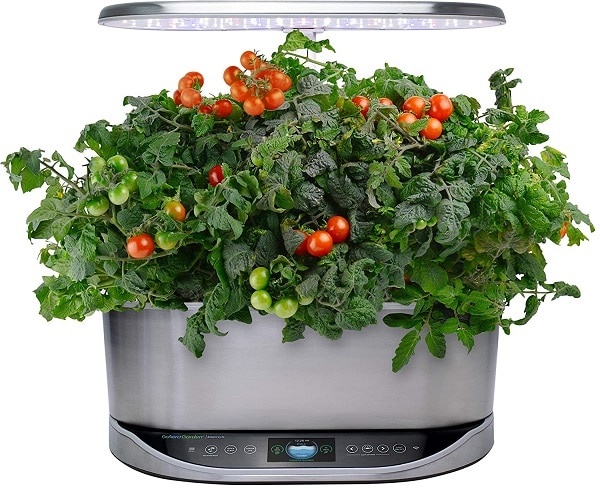 AeroGarden Bounty Elite - Indoor Garden with LED Grow Light
AeroGarden Bounty Elite - Indoor Garden with LED Grow Light
- WiFi and Alexa Compatible, Stainless Steel Grow up to 9 plants, up to 24duim
- Includes everything you need to grow
- 50 watt LED Grow Lights, perfect spectrum for fast growth & big harvests
When the plant begins to form visible roots, move it to the growing medium. Provide it with the proper nutrient solution in the hydroponics system. Once the flower has developed, pollinate female flowers. Use pollen from male stamens to encourage fruit production. Similar to other melons, they can’t produce the fruit without pollination. Gather the melons when the tendrils near the mature melon start to dry and become brown.
Hydroponic Berries (hydroponic Raspberries, Blueberries hydroponics, hydroponic Cranberries)

Hydroponic berries are less common in hydroponic cultivation than strawberries. However, they’re suitable for selling and producing. They have the advantage of the protected and controlled environment of an indoor garden.
There’re some kinds of berries that you can cultivate in your soilless garden. They’re blueberries, raspberries, and cranberries.
It’d be perfect if you grow them in a high system above the ground. This placement makes their stems fall. So, this will allow you to have straight access to the fruits for trimming.
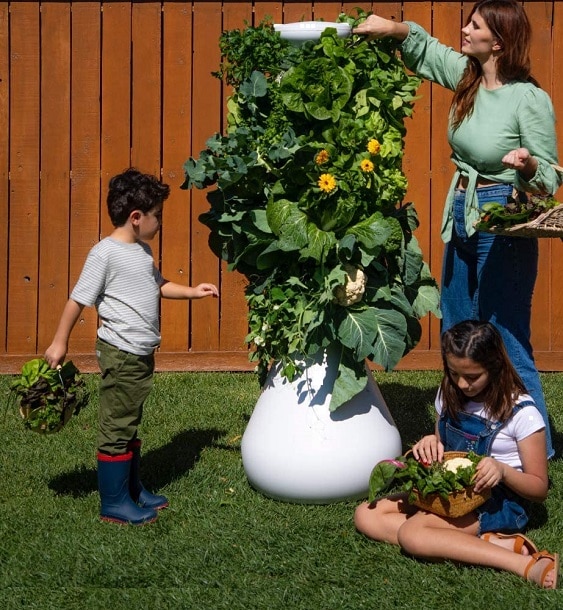 Lettuce Grow 36-Plant Hydroponic Growing System Kit
Lettuce Grow 36-Plant Hydroponic Growing System Kit
- Large Home Organic Gardening with Self Watering with Pump, BPA Free and Food Grade
- Outdoor Indoor Vertical Garden Herb Vegetable Planter Tower
- All the gear: farmstand tower, water pump, power cord, timer; and Nutrients for 130+ Plants
Important Things for Blueberry Hydroponic
One of the most important things with starting hydroponic berries is to expose their rooting to too many nutrients. So, choosing a drip system is your best decision. The system allows you to customize how many nutrients are fed. You can also make sure that the roots get the nutrient-rich mix slowly and smoothly.
Berry crops don’t need high temperatures. They can grow under conditions comparable to many other fruit plants. Temperatures between 72 and 74°F during the day and 68 to 70°F at night are ideal for growing. To get the highest fruit quality, the light needs are similar to tomatoes. The plants benefit from a long day of light exposure.
The nutrition of all berry crops is tied together. A well-balanced nutrient mix is necessary for early growth stages following initial bud breakage. This is followed by a nutrient formulation for flowering or fruiting that is high in potassium once the fruit set has been reached.
3 tips to Grow Blueberries in Hydroponics
Here are three tips for growing blueberries hydroponically:
- Choose the right variety: Blueberries are sensitive to pH levels and require acidic soil. Look for blueberry varieties that are well-suited for hydroponic growing and can thrive in a pH range of 4.0-5.0.
- Use a suitable growing medium: Blueberries require a growing medium that provides good drainage and retains moisture, such as peat moss or coconut coir. Avoid using soil, as it can lead to root rot in a hydroponic system.
- Monitor and adjust pH and nutrient levels: Hydroponic systems require precise pH and nutrient levels for optimal plant growth. Monitor these levels regularly and adjust as necessary to ensure that the blueberries are receiving the correct balance of nutrients and acidity.
By following these tips, you can successfully grow blueberries hydroponically and enjoy the benefits of fresh berries year-round.
3 mistakes of Growing Hydroponic Blueberries
Here are three common mistakes to avoid when growing hydroponic blueberries:
- Neglecting pH levels: Blueberries require acidic soil, and it’s important to monitor and adjust the pH levels regularly in a hydroponic system. Neglecting pH levels can lead to nutrient deficiencies and stunted growth.
- Overcrowding plants: Blueberry plants require adequate space to grow and produce fruit. Overcrowding plants in a hydroponic system can lead to reduced yields and increased risk of pests and diseases.
- Choosing the wrong variety: Not all blueberry varieties are well-suited for hydroponic growing. Some may be more susceptible to diseases or nutrient deficiencies. It’s important to choose a variety that is well-suited for hydroponic growing and can thrive in the specific conditions of your system.
By avoiding these common mistakes, you can increase your chances of success in growing hydroponic blueberries and enjoy the benefits of fresh fruit year-round.
Grapes Hydroponics

Every time you think about hydroponics, you probably don’t think about grapes. But you can grow grapes inside, too! Think about hydroponic grape trees. The grapes are an exquisite snack to savor all year round. Especially, they’re good in a hydroponics garden.
Your grapes need to have ropes, trellises, or threads for their climbers. Sufficient support for fruit weight maintenance will help get juicier and better yields.
The superior system to grow grapes is drip irrigation. It’ll keep up a comfortable humidity level. Also, it allows the roots to dry out afterward. Most grapes in a drip irrigation system have high sugar content. It results in better skin quality and a more juicy texture.
If you decide to start with a seed, you may need to be patient before eventually getting fruit off the tree. Maturation of most tree species takes between three and five years. If you buy a tree from your local nursery, look for a strong young tree that is closest to bearing fruit.
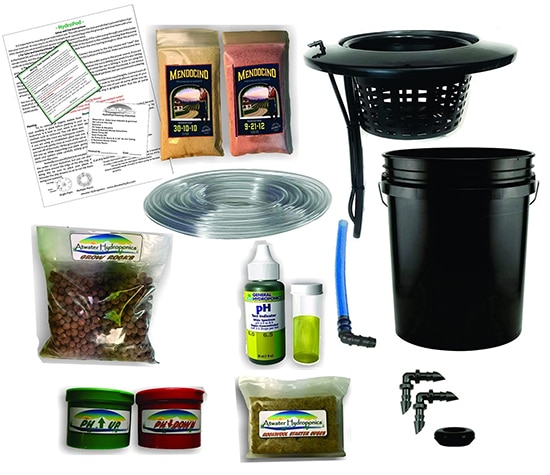 The Atwater HydroPod - Standard A/C Powered DWC/Recirculating Drip Hydroponic Garden System Kit
The Atwater HydroPod - Standard A/C Powered DWC/Recirculating Drip Hydroponic Garden System Kit
- Most efficient use of water compared to traditional gardening
- Dual outlet air pump, Nutrients are Included!
- Kit contains everything you need to start your own garden (minus plants and water!)
Like many of the berry varieties, growing your grapes from cuttings instead of seeds is possible. You need to ensure that the roots are surrounded by a substrate that can drain quickly. They’re coconut fiber or perlite.
Tips How to Grow Hydroponic Grapes
- Choose the right variety: Some grape varieties are better suited for hydroponic growing than others. Look for varieties that have a compact growth habit and are disease-resistant.
- Use a suitable growing medium: Grapes require a growing medium that provides good drainage and retains moisture, such as coconut coir or perlite. Avoid using soil, as it can lead to root rot in a hydroponic system.
- Provide adequate light: Grapes require plenty of light to produce a high yield. Provide at least 10-12 hours of artificial lighting per day, or place the hydroponic system in a location that receives plenty of natural sunlight.
- Monitor and adjust pH and nutrient levels: Hydroponic systems require precise pH and nutrient levels for optimal plant growth. Monitor these levels regularly and adjust as necessary.
- Train the vines: Grape vines require training to grow properly and produce a high yield. Use a trellis or other support system to train the vines and promote healthy growth.
- Prune regularly: Regular pruning can promote healthy growth and prevent overcrowding in hydroponic grape plants. Prune back the canes to encourage new growth and a higher yield.
- Control pests and diseases: Keep a close eye on your hydroponic grape plants for signs of pests or diseases, such as spider mites or powdery mildew. Use organic pest control methods or remove infected plants to prevent further spread.
Hydroponic Cantaloupe
Probably, one of the most widespread melons in the world, cantaloupe, isn’t as difficult to grow hydroponically as you think. You can go the same way of growing cantaloupe with other tropical melons. They’re musk melons.
These fruits usually need temperatures from 72 to 90 degrees Fahrenheit. Moisture and temperature will have a significant effect on the fruit set. You need to build the identical circadian rhythm as they’d experience the outdoors in the wild. It’s a good idea to think about lowering temperatures in the nighttime when their lights are out.
Another good piece of advice is to ensure that their roots are slightly cooler than the rest of the fruit. The choice of a deep-sea hydroponic culture system is best for cantaloupes due to their wide leaves.
Such fruit also needs adequate oxygenation near their roots. It ensures that melons receive more than enough food. Besides, make sure to set up a bubble stone to supply surplus oxygen to the rooting. Particularly with deep water cultivation.
The most important fall for the cantaloupe is that its seeds are amongst the most expensive. You need to ensure that when you start the seeds, you don’t have to worry about replanting them later.
One of the best tips is to start your melon seeds with Rockwool to allow high humidity.
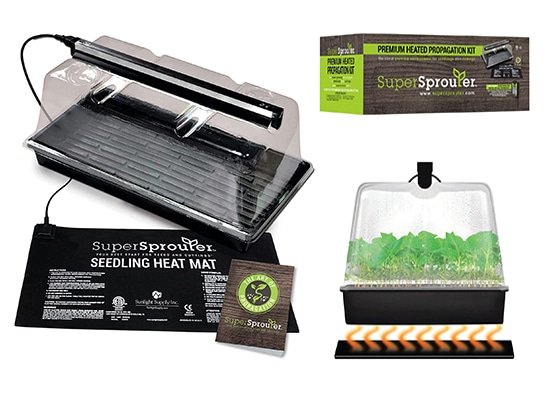 Super Sprouter Premium Propagation Kit with Heat Mat, 10
Super Sprouter Premium Propagation Kit with Heat Mat, 10
- Dome & T5 Light, 5 Piece, Black/Clear
- Art of Propagation booklet with expert advice for starting seedlings and cuttings
- Super Sprouter Seedling Heat Mat 10 in x 21 in is ETL listed
How to Grow Hydroponic Fruit Indoors
Technically, it’s possible to grow any fruit in hydroponics. Some types of fruit grow better in hydroponics than others. Let’s see what you need to grow hydroponic fruit indoors.
What Nutrients to Use for Hydroponic Fruit
To survive, plants must breathe, obtain humidity, and do photosynthesis. And they appear as oxygen, carbon, hydrogen, and nitrogen. And plants can take those things out of the environment. So, you should first take care of them. And only after that, move on to the supplements.
Macronutrients
Your hydroponic fruit needs the following macronutrients:
- Nitrogen. Plants with no nitrogen are showing symptoms with yellow leaves. The older and lower leaves will have the effects first and fall quickly.
- Phosphorus. Phosphorus plays an important role in the development of flowering, fruits, seeds, and roots.
- Potassium. Your plant needs it in large amounts for effective plant development and reproduction.
- Calcium. It’s necessary for the formation and growth of cells.
- Sulfur. A structural constituent of two of the 21 amino acids that create proteins. It also helps stimulate and shape certain enzymes and vitamins.
- Magnesium. It helps create oxygen by photosynthesis. It’s often used in large quantities in rapidly growing plants.
Among them, the three macronutrients (N, P, K) are the most important nutrients for the development of the plant.
Micronutrients
Micronutrients are still important for the development of plants. However, you should add them in smaller quantities. They’re the following:
- Zinc. It plays an important role in the formation of chlorophyll and other engines.
- Boron. It’s used along with calcium to synthesize cell membrane structure and functions.
- Iron. A component of numerous enzymes related to energy delivery, nitrogen fixation. It helps form chlorophyll.
- Manganese (Mn). It catalyzes the growth process. Also, the element contributes to forming oxygen through photosynthesis.
How Long Does It Take to Grow Fruit Hydroponically?
The time frame varies regarding each fruit. So, let’s look at how long it takes to grow hydroponic strawberries, watermelons, berries, grapes, and cantaloupe.
Strawberries
Strawberries are suitable for hydroponics. They are one of the most popular crops in commercial hydroponics. For the fastest results, use strawberries from rootstocks for hydroponics rather than those from seed. The use of specific varieties can reduce the months or even years of growing.
Watermelons
Germination is quickest between 27 and 30°C. Young plants are ready to move into a hydroelectric system within two weeks. Many producers make the mistake of keeping larger seedlings like watermelons on their trays too long. In ideal conditions, the plants grow fast.
Berries
Blueberries, an excellent fruit rich in vitamins for your meal, can be cultivated well in hydroponics. This plant takes more time to grow than strawberries, often up to the second year. They’re typically grown within an NFT system. Because it’s difficult to plant blueberries from seeds, it’s a good idea to transplant them.
Grapes
The grapes will grow in a hydroponics system as long as they’re getting support and an adequate flow of nutrients. The average time to produce grapes is between three and five years.
Cantaloupe
You can grow cantaloupe under warm conditions up to 4 cycles per year. It takes approximately 80 days from planting to harvest.
How Much Light Needed for Hydroponic Fruit
Growing indoors, you need to decide whether to use artificial lighting or natural sunlight. If you use natural sunlight indoors, make sure your plants get enough sunlight to grow efficiently. One option you have is to place them into pots or containers and move them near a window.
Place them too close together as overcrowding, however, may become a problem. When you put, for example, strawberries too close together, they may be more susceptible to disease and mold on them. Strawberries love to have lots of space to grow and flower. Appropriate spacing is critical to the growth of many fruits like watermelons. With berries, on the contrary, it’s not so important.
Another issue is having enough exposure to the sun. The minimum amount of light necessary for berry cultivation is six hours of sunshine per day. They do, however, need more light so you can get your plants into an area that has the most sunlight exposure where you live. If you begin your plants from a seed, it’s preferable to freeze them for about half a month to a month. It’ll make them sprout more quickly.
There are different kinds of lighting systems that work well for growing strawberries indoors. The full-spectrum lights that provide all the natural sunlight are a popular choice for an indoor garden. Fruit growers like to use this type of lighting.
What Is PPM for Fruit in a Hydroponic?
I advise on hydroponics and environmental conditions for optimal plant health and fruit growth:
- A pH between 5.5 and 6.0 is ideal.
- Maintain total salt concentration between 800 and 900 ppm early in growth. Under 400 – 500 ppm during the bloom/fruiting stage or yield will suffer.
- The water temperature from 65 to 72 degrees Fahrenheit is the best.
- Allow at least 6 hours of full sun or 12 to 14 hours of artificial lighting per day.
- Low humidity.
- Pinch the runners because this will help raise and keep up fruit production.
The PPM of the nutrient and water solution in the reservoir increases with the addition of fertilizers to the hydroponic system. Weekly change of water eliminates excess salts and nutrients. It ensures that the pH of the reservoir stays between 5.5 and 6.5 and that nitrogen, phosphorous, and potassium levels are consistent.
Generally speaking, plants will need more nutrients in the colder months. Respectively, it’ll be less in the warmer months. As a result, you have to maintain a stronger nutrient solution in the winter, with a lower solution in summer when plants absorb and sweat more water than nutrients.
How to Grow Raspberry Hydroponics
Here are the steps to grow raspberries hydroponically:
- Choose the right variety: Not all raspberry varieties are well-suited for hydroponic growing. Look for varieties that are compact, disease-resistant, and produce a high yield.
- Set up the hydroponic system: Raspberries can be grown in a variety of hydroponic systems, including NFT or drip irrigation systems. Set up the system according to the manufacturer’s instructions.
- Use a suitable growing medium: Raspberries require a well-draining growing medium that retains moisture, such as coconut coir or perlite. Avoid using soil, as it can lead to root rot in a hydroponic system.
- Provide adequate light: Raspberries require plenty of light to produce a high yield. Provide at least 10-12 hours of artificial lighting per day, or place the hydroponic system in a location that receives plenty of natural sunlight.
- Monitor and adjust pH and nutrient levels: Hydroponic systems require precise pH and nutrient levels for optimal plant growth. Monitor these levels regularly and adjust as necessary.
- Prune regularly: Regular pruning can promote healthy growth and prevent overcrowding in hydroponic raspberry plants. Prune back the canes to encourage new growth and a higher yield.
- Control pests and diseases: Keep a close eye on your hydroponic raspberry plants for signs of pests or diseases, such as spider mites or powdery mildew. Use organic pest control methods or remove infected plants to prevent further spread.
By following these steps, you can successfully grow raspberries hydroponically and enjoy the benefits of fresh berries year-round.
Conclusion
Well, these are just a couple of the best options for your hydroponics garden. It may seem overwhelming to cultivate them. But over time, the process will become much simpler. This is because hydroponic farming is not only sustainable but also fast, simple, and hassle-free, with far fewer obstacles than traditional gardening. Growing your favorite healthy and juicy fruit isn’t that hard now with hydroponics. Now, you know how to start your fruit garden right at your place! Let me know if you liked the post in the comments down below!
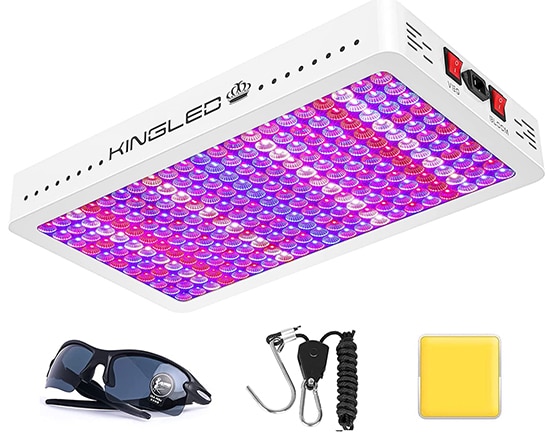 KingLED Newest 3000w LED Grow Lights with LM301B LEDs and 10x Optical Condenser 6x6 ft
KingLED Newest 3000w LED Grow Lights with LM301B LEDs and 10x Optical Condenser 6x6 ft
- Coverage Full Spectrum Grow Lights
- For Indoor Hydroponic Plants Veg Bloom
- 3 years Professional Service and free return for 90 days
FAQ
Is Hydroponic Fruit Healthy?
With hydroponics, you simply need water and nutrients. This is a much easier and cleaner solution. This is why you don't need to worry about any foreign contaminant invading your food supply or your immediate environment. The plants you grow in your house with hydroponics don’t have harmful chemical pesticides. The pest contagion is impossible since soilless farming restricts the danger of infection attacks.
Can Pineapples Be Grown Hydroponically?
You can grow pineapples hydroponically or soil-free. In a hydroponic system, you have to place pineapples in a water and nutrient solution that is directly accessible to the roots. The growing environment shortens the time that pineapples traditionally want to plant in the ground and find water to survive. Growing pineapple hydroponically gives you complete control over nutrient intake. And it’s less likely to experience plant-derived pests and diseases.
Which Berries Can Be Grown Hydroponically?
You can grow blueberries, cranberries, and raspberries hydroponically. Hydroponic cranberries and raspberries can all be produced on a limited scale through the sale of greenhouse crops. Many of them would have to be in high tunnels to prolong the harvest season and improve fruit quality. However, you can also cultivate them indoors. Blueberries, which need extremely acidic conditions in the soil, have few different requirements in hydroponic solution.
What Is the Best Water to Use For Hydroponics?
The number one choice is to buy distilled water and dilute your tap water to reduce PPM to a level appropriate for hydroponic cultivation. The next option is to pass the water through an inverse osmosis liquid filter. The benefits of using distilled water for hydroponic cultivation are clear. Starting from clean water means that fruit gets nutrients directly, with no chemicals or contaminants, or even minerals present in tap water.
Is Hydroponics Dangerous?
When you take into account the requirements for growing hydroponics indoors, you don’t have to worry. But, the extreme heat may cause some troubles. The high humidity content of the air around hydroponic crops may encourage mold and other plant pathogens to grow and spread rapidly. You can avoid it by paying proper attention to ventilation. Particularly when plants are in bloom or fructifying and are more vulnerable.
Is Growing Hydroponics Easy?
Hydroponic cultivation is no harder than traditional gardening. It’s practically as simple as soil. Using hydroponics means you're skipping the ground and delivering nutrient-rich water directly to the roots. The hydroponics system enables plants to directly absorb nutrients. It’s thanks to the advantages of water-based nutrient distribution systems. The root of the plant “eats” the solution. It makes it very easy for the plant to use what it needs. So, it grows properly.
Can I Use Any Liquid Fertilizer for Hydroponics?
Yes, it’s possible to use any regular fertilizers for hydroponic cultivation. But actually, you shouldn’t do that. Regular fertilizers lack many components that specially designed hydroponic nutrients contain. And they can cause problems at various stages of growth. Liquid fertilizers come in a solution of 1-2 or 3 parts and according to your plants’ needs. With this, there’s no addition of extra supplements since the necessary elements are already there.
Does Hydroponics Use a Lot of Electricity?
Pumps and other equipment for hydroponics consume little power compared to lighting costs. Yet, even low-usage devices will add utility bills. In the end, the consumer inherits high electricity costs from hydroponics gardening. On average, each square foot of growth area requires at least 32 watts. While having illumination with 52 and 80 watts shows better results, a light system with 32 watts is stronger. It can significantly cut back your regular light costs.
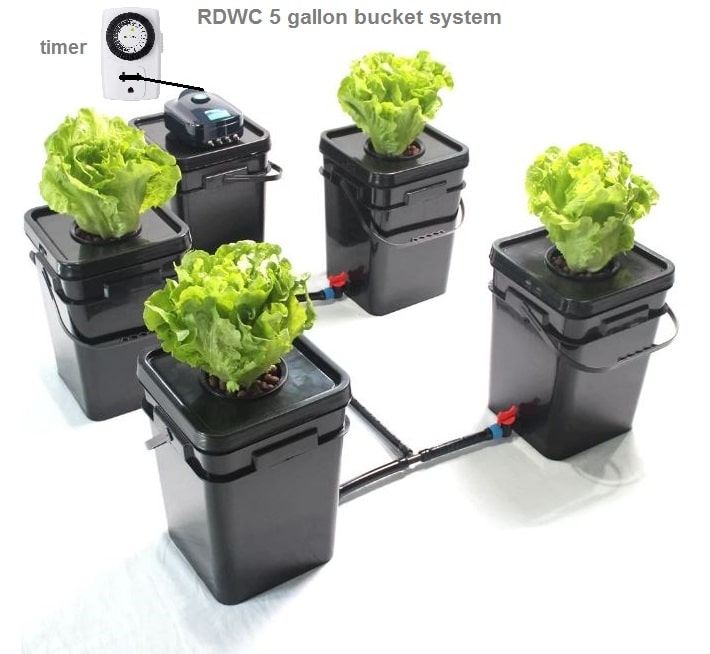
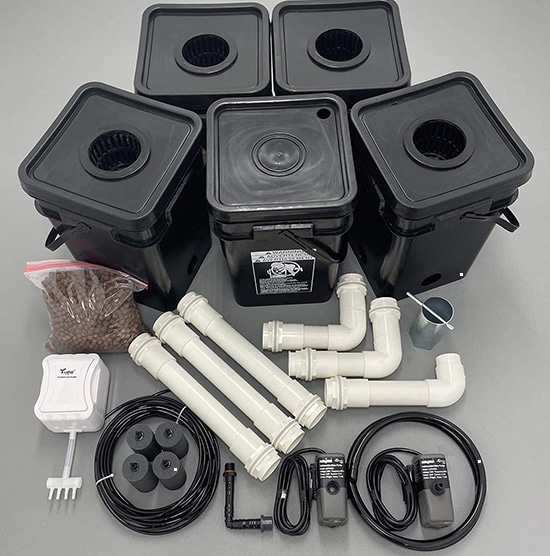 Recirculating Deep Water Culture (RDWC) Hydroponic Grow Kit System
Recirculating Deep Water Culture (RDWC) Hydroponic Grow Kit System
- Reservoir Bucket Connected to 4 Grow Buckets
- 400 Gallon/hour Circulating Pump
- Large 5 gallon square buckets, pre-drilled
